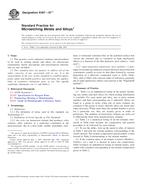Potrebujeme váš súhlas na využitie jednotlivých dát, aby sa vám okrem iného mohli ukazovať informácie týkajúce sa vašich záujmov. Súhlas udelíte kliknutím na tlačidlo „OK“.
ASTM E3-11
Standard Guide for Preparation of Metallographic Specimens
Automaticky preložený názov:
Štandardné Príručka pre prípravu metalografických vzoriek
NORMA vydaná dňa 1.5.2011
Informácie o norme:
Označenie normy: ASTM E3-11
Poznámka: NEPLATNÁ
Dátum vydania normy: 1.5.2011
Kód tovaru: NS-46334
Počet strán: 12
Približná hmotnosť: 36 g (0.08 libier)
Krajina: Americká technická norma
Kategória: Technické normy ASTM
Kategórie - podobné normy:
Anotácia textu normy ASTM E3-11 :
Keywords:
alloys, grinding, metallography, metals, mounting, polishing, sectioning, specimen preparation (metallographic), Specimen preparation (for testing)--metals/alloys, Structural metals/alloys, Cleaning agents/processes, Electropolishing, Etching (materials/process), Grinding materials/operations, Inclusions--metals/alloys, Metallographic analysis/inspection, Metallurgical materials/applications, Metals and metallic materials--inclusion rating, Microscopic examination--metals/alloys
Doplňujúce informácie
| Significance and Use | ||||||||||||||||||||
|
Microstructures have a strong influence on the properties and successful application of metals and alloys. Determination and control of microstructure requires the use of metallographic examination. Many specifications contain a requirement regarding microstructure; hence, a major use for metallographic examination is inspection to ensure that the requirement is met. Other major uses for metallographic examination are in failure analysis, and in research and development. Proper choice of specimen location and orientation will minimize the number of specimens required and simplify their interpretation. It is easy to take too few specimens for study, but it is seldom that too many are studied. |
||||||||||||||||||||
| 1. Scope | ||||||||||||||||||||
|
1.1 The primary objective of metallographic examinations is to reveal the constituents and structure of metals and their alloys by means of a light optical or scanning electron microscope. In special cases, the objective of the examination may require the development of less detail than in other cases but, under nearly all conditions, the proper selection and preparation of the specimen is of major importance. Because of the diversity in available equipment and the wide variety of problems encountered, the following text presents for the guidance of the metallographer only those practices which experience has shown are generally satisfactory; it cannot and does not describe the variations in technique required to solve individual specimen preparation problems. Note 1—For a more extensive description of various metallographic techniques, refer to Samuels, L. E., Metallographic Polishing by Mechanical Methods, American Society for Metals (ASM) Metals Park, OH, 3rd Ed., 1982; Petzow, G., Metallographic Etching, ASM, 1978; and VanderVoort, G., Metallography: Principles and Practice, McGraw Hill, NY, 2nd Ed., 1999. 1.2 This standard does not purport to address all of the safety concerns, if any, associated with its use. It is the responsibility of the user of this standard to establish appropriate safety and health practices and determine the applicability of regulatory limitations prior to use. |
||||||||||||||||||||
| 2. Referenced Documents | ||||||||||||||||||||
|
Podobné normy:
Historická
1.6.2013
Historická
1.5.2007
Historická
1.6.2013
Historická
1.5.2013
Historická
1.10.2011
Historická
1.10.2009



 ASTM E340-13
ASTM E340-13 ASTM E407-07e1
ASTM E407-07e1 ASTM E433-71(2013)..
ASTM E433-71(2013).. ASTM E45-13
ASTM E45-13 ASTM E562-11
ASTM E562-11 ASTM E7-03(2009)..
ASTM E7-03(2009)..
 Cookies
Cookies
